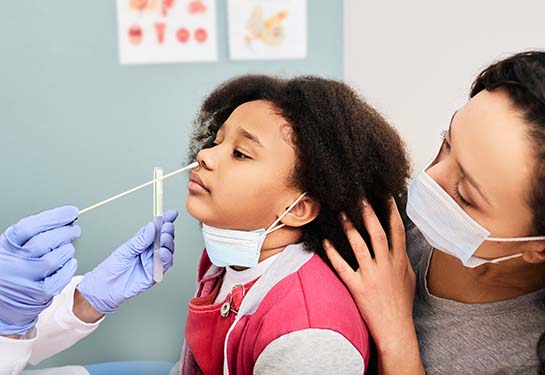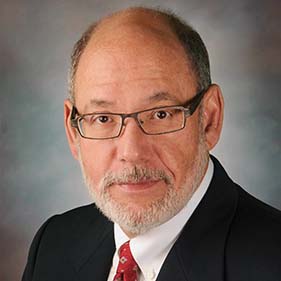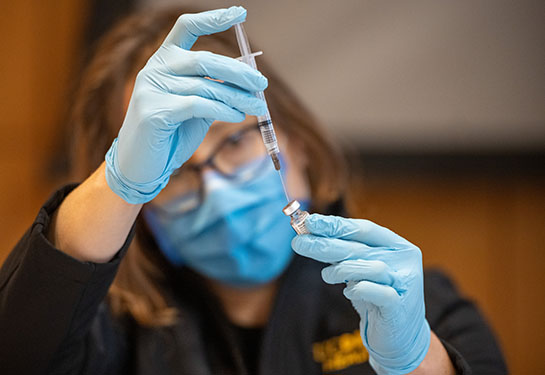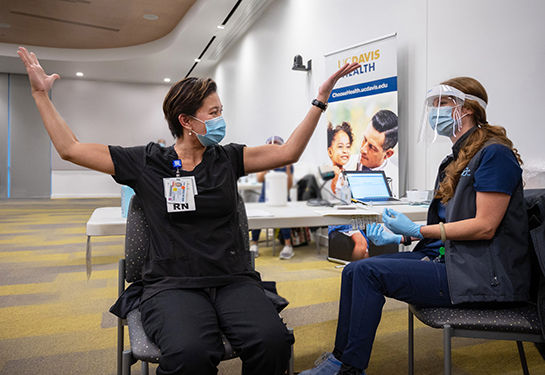Omicron: 10 things to know about the very contagious COVID-19 variant
Health experts weigh in on symptoms, testing, masking and more
In a very short time, the highly infectious Omicron COVID-19 variant has upended many aspects of our lives. Both California and Sacramento County are seeing record numbers of infections and testing is in great demand. Statewide, the positivity rate is over 21%. Luckily, Omicron appears to cause milder illness in many people. At UC Davis Medical Center, COVID-related hospitalizations have ticked up, but remain below previous surge peaks.
UC Davis Health infectious diseases experts, epidemiologists and public health experts answer common questions about Omicron and explain what you can do to reduce your risk.
1. What are the symptoms of Omicron? Are they different?
All of the variants, including Delta and Omicron, cause similar symptoms. “These may include cough, fever and fatigue,” explained Dean Blumberg, chief of pediatric infectious diseases at UC Davis Children’s Hospital. “Omicron is less likely to cause severe disease such as pneumonia that may require hospital admission.”
Lorena Garcia, epidemiologist and professor in the Department of Public Health Sciences noted that Omicron symptoms are about the same, but a person’s experience may vary greatly depending on whether they’re vaccinated. “In those that are fully vaccinated and boosted, symptoms tend to be mild. In contrast, if an individual is unvaccinated, symptoms can be quite severe, resulting in hospitalization or even death,” Garcia said. She added that there is some evidence that fewer people infected with Omicron are experiencing a loss of taste and smell, a common symptom for previous variants.
The viral load is much higher in Omicron, which means that someone infected with the Omicron variant is more infectious than someone infected with the Delta variant.” —Lorena Garcia
2. What should I do if I can’t get a COVID test?
The rapid increase in demand has made testing more challenging. “If possible, check different testing sites and try to be flexible in terms of when and where you are willing to go,” Blumberg recommended.
If you’re seeking a test, please seek options other than the Emergency Department (ED). UC Davis Medical Center’s ED has seen a record number of patients recently, and providers need to care for those who are seriously ill. The ED is not the best fit for someone with no symptoms or mild symptoms.
“If you have COVID-19 symptoms, it is better to err on the side of caution and quarantine until you can get tested,” advised Brad Pollock, professor and chair of the Department of Public Health Sciences. “If you have symptoms, the rapid antigen at-home tests are also useful to determine whether you’re infectious. Even better, use rapid tests on two consecutive days to reduce the chance of transmitting the infection to others.”
Learn more about the different types of COVID-19 tests available.
3. Should I get a rapid antigen test if I have symptoms since they seem like they’re not as accurate, or should I look first to get a PCR test?
“If a rapid test is more available or convenient, it’s a good idea to use it,” Blumberg said. “If it’s positive, you can rely on the result.” However, he notes that if the rapid test is negative, particularly if you suspect infection, it’s best to get a PCR test to double-check since the PCR test is more sensitive.
4. Do I really need to know if I had COVID if it’s not causing serious illness?
Yes. UC Davis Health experts say it’s important to know for several reasons:
- If your illness progresses, you’ll want to know so you can take advantage of treatments.
- You need to know whether to isolate so you can reduce your chances of infecting others, especially those who are more vulnerable to severe COVID-19.
- You will want to notify your loved ones and contacts so they can monitor themselves for symptoms.
“We all have a personal responsibility to reduce the risk to others, especially the more vulnerable among us,” Pollock said.
Omicron is less likely to cause severe disease such as pneumonia that may require hospital admission.” —Dean Blumberg
5. If I’m vaccinated and have no symptoms, but believe I was exposed to someone with COVID-19, should I get tested?
Most likely. “Unfortunately, Omicron is so transmissible that even fully vaccinated and boosted individuals may get infected,” Pollock explained. “If you know you had contact with an infected individual, particularly in a higher-risk situation (such as an enclosed indoor space for a longer period with others who weren’t masked), testing is advised.”
The Centers for Disease Control (CDC) recommends that you get tested 5-7 days after “close contact with a person with suspected or confirmed COVID-19.” The CDC defines close contact as being less than 6 feet away from an infected person for a total of 15 minutes or more over a 24-hour period.
Garcia said that in addition to getting tested, you should also quarantine. “Watch for symptoms, distance yourself socially from others in your home and wear a mask. If you test positive, then you should isolate.”
Learn more about the difference between quarantine and isolation and read Sacramento County’s quarantine and isolation guidelines.
Blumberg noted that if you were in a situation where individuals were outside, masked and distanced, the risk of infection is much lower. “In that case, you could monitor for symptoms and test if any develop.”
6. Can I get reinfected if I’ve already had COVID-19? What if I’m also vaccinated?
Yes. “You can get reinfected after having COVID-19, although it is less common in the first 90 days after infection,” explained Blumberg. He noted that the vaccines are not 100% effective and breakthrough infections may occur. “However, if you’ve had COVID-19 and are then vaccinated, this decreases your chance of reinfection by about half.”
Vaccine protection wanes over time, Garcia added. “This is something we expected to occur with vaccinated individuals, hence boosters are important, particularly for front line workers and those at higher risk of complications, such as those with diabetes and respiratory illnesses.”
7. How is Omicron presenting in vulnerable populations such as senior citizens and those with multiple underlying conditions?
Most Omicron infections have occurred in relatively young, healthy people. “We still don’t know how dangerous it is in people over 65 or those who are immunocompromised, but there is a concern that they may be at higher risk for severe disease,” Blumberg said. “We urge them to take all available precautions, including vaccination with boosters and masking.”
Omicron is highly transmissible compared to Delta, Garcia noted. “The viral load is much higher in Omicron, which means that someone infected with the Omicron variant is more infectious than someone infected with the Delta variant. Older adults and those with compromised immune systems should take special care,” she said.
We all have a personal responsibility to reduce the risk to others, especially the more vulnerable among us.” —Brad Pollock
8. Why should I continue to wear a mask?
Omicron is incredibly infectious. “Everyone should be masking when indoors around anyone not in their household, as well as in crowded areas outdoors where it is impossible to socially distance, like sporting events,” Blumberg said. Several studies have indicated how effective masks can be in protecting yourself and others. “But remember it’s important to cover both the mouth and nose, as COVID-19 can be found in the nose, mouth and throat,” reminded Garcia.
9. How effective are cloth face masks vs. surgical face masks vs. N95 face masks?
“It’s difficult to estimate the protection from cloth masks since they aren’t standardized,” noted Blumberg, “But some studies suggest they are about 50% effective, compared to 60-70% for surgical masks and 95% for N95s.”
Pollock noted that there’s strong evidence that properly worn N95 masks are the most protective in terms of blocking transmission. “Cloth masks alone are not very effective against the most transmissible variants like Delta and Omicron. If an N95 mask is not available, a surgical mask covered with a cloth mask can be very effective because the cloth mask acts as a holder to ensure that the surgical mask underneath fits tight,” he advised.
10. Where can I find a testing site?
Sacramento, Placer, El Dorado, Yuba, Sutter, Yolo and other counties offer no-cost COVID-19 testing at many locations. Some clinics are walk-in, and others require an appointment. Most testing is free, but some rapid tests require a fee. This map of test sites and this list from the Sacramento County COVID-19 Collaborative are also helpful. The State of California also has a website with information about COVID-19 testing and a searchable map listing different testing sites.
Learn more about scheduling a COVID-19 vaccine at UC Davis Health or through the state of California’s vaccine site.







